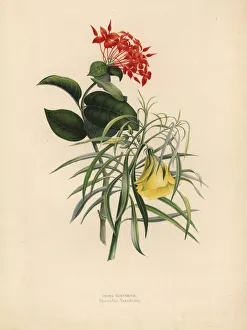Ixora Collection
Ixora, a captivating flower with a rich cultural significance, holds various meanings across different contexts
All Professionally Made to Order for Quick Shipping
Ixora, a captivating flower with a rich cultural significance, holds various meanings across different contexts. In Hindu mythology, Ixora is depicted as an Indian God with three eyes and sixteen hands, radiating divine power. This engraving from c. 1780 beautifully captures the essence of this deity. However, it also refers to a species of flowering plant known as Ixora chinensis. With its vibrant blooms and delicate petals, it adds splashes of color to gardens worldwide. Often found alongside rye grass, African corn lily, and jungle geraniums, the combination creates a mesmerizing tapestry of nature's beauty. In some regions like the Philippines' Central Visayas province in Anda Bohol, you can witness the enchanting sight of yellow ixoras in full bloom. Against the backdrop of lush greenery and yellow oleanders, these flowers create an awe-inspiring spectacle that leaves visitors spellbound. The religious significance attached to Ixora is evident in ceremonies and customs observed by devotees in East India, and is believed that prayers offered to Ixora (Shiva) bring blessings and protection for those seeking solace or healing during difficult times. The image depicting a sick person presented before this Indian deity showcases the faith people place in their belief system. Ixora coccinea is another variant within this diverse family of plants; its bright red hue symbolizes vitality and passion while exuding warmth wherever it grows. Paired with Hosta plantaginea on Plate 11, they form an exquisite blend that captivates all who behold them. Indeed, throughout history and across cultures worldwide, people have sought help from deities like Ixora when faced with challenges or uncertainties—a testament to humanity's enduring spiritual connection beyond borders.










